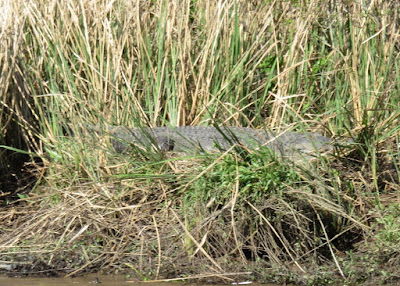
One of life’s great joys is sharing special places with
good friends. Over the years we’ve had a
chance to visit many such places with our friends Steve and Robin, so it was
wonderful to be able to meet them as we returned for the third time to
Huntington Beach State Park. Steve and
Robin were vacationing in Myrtle Beach and we were heading south for our long
awaited Florida vacation.
We started the day with the requisite long walk along the
beach admiring the surf, the warm weather, the pelicans, the shorebirds, and
our good fortune to be on such a pretty beach on such a pretty day! After a quick picnic lunch, we walked along
the marsh boardwalk at low tide admiring the tiny, busy crabs excavating their
tiny crab holes, the warm weather, the wading birds, and our good fortune to be
out in the marsh on such a pretty day! [Have
you noticed a trend?] It was here that we took our traditional selfie.
Across the street from the park are the Brookgreen
Gardens. Once also part of the Huntington’s
(for whom the state park is named) estate, the Gardens were planned by Mr. and Mrs. Huntington as a
place to showcase (Mrs.) Anna Hyatt Huntington’s sculptures. It has evolved to be the largest sculpture
garden in the world (9,100 acres – though much of that is wetland), with thousands
of figurative sculptures set among lovely plantings, fountains and pools of water. The sculptures are eclectic in topic, style,
and era. They are brooding and
boisterous, sleek and ornate, metal and stone. You can sit on a park bench next to a sculpture
of a man reading a newspaper. You can
contemplate a dazed Don Quixote riding his gaunt horse. The Gardens are huge and uplifting and
exhausting. We didn’t see nearly all of
it.
A high point of the Gardens are a boat tour through the
reclaimed rice paddies that were once part of the 4 failed rice plantations
that the Huntingtons purchased in the 1920s.
The narrator talks about the history of rice cultivation in that
area. It took 7 years for enslaved
workers to clear the wetland of all plants including digging up the roots, and then
building dikes around the 40 acres to make a rice paddy. This is before the first grain of seed rice
went into the soil. All surrounded by exhausting
heat, malaria carrying mosquitoes, poisonous snakes, and alligators. Sobering and awful. Interestingly, many of the successful
innovations in rice agriculture which made this area so profitable were rice growing techniques brought by the
slaves from their homes in West Africa. The
county where these plantations were located had 20,000 inhabitants at the
height of rice production – 18,000 of whom were slaves. Between the historical information he also
pointed out interesting birds and creatures we saw along the way.
Foot weary and satisfied we went to the Inlet
Crab House in Murrells Inlet for dinner, followed by a walk along the Marsh
Walk there. Dana’s total steps for the
day - 16,900.





 |
| Full Moon Over the Atlantic - So Bright it Cast a Shadow |
 |
| Morning Moon over the ShoreXplorer |
 |
| Basking 'Gator from the Boat Tour |




Hi Dana and Russ,
ReplyDeleteWe are so enjoying your blog, with the narrative and photos - great to see you enjoying yourselves as you travel and thanks for sharing the journey!!
Much love,
Catherine and Jane in D.C.